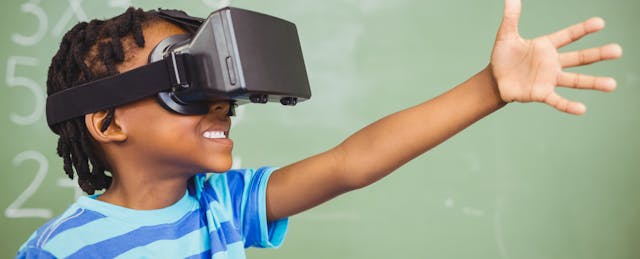When I wrote about my high hopes for edtech back in August, student-created virtual reality was near the top of my list. I envisioned students incorporating guided VR into presentations, and creating augmented reality-triggered videos to explain their learning. Since then, VR has taken off in popularity, but there are still plenty of critics who wonder if the hype is worth the investment.
To find out, I spoke to educators from across grade levels and content areas who are actually using VR with their students. Based on their experiences, it appears VR has plenty of potential—especially when it comes to engagement. Here's a run-down on the perks from some of America’s early-adopters.
Students Experience Content, Instead of Just Watching It
Anthony Caccavo is a middle school curriculum coordinator and social studies teacher at St. John’s Prep in Massachusetts. He strives to use mixed media in his classroom—primary sources, artwork, movies. But Caccavo explains that “documentaries, no matter the quality, often leave students sitting passively in their seats while images and words stream in front of them.” With virtual reality, however, he says his students “began to explore.”
Caccavo uses virtual reality movies from WITHIN and RYOT to help expose students to new perspectives. In a unit on the refugee experience throughout history, he shows students 3D films like Clouds Over Sidra and The Crossing, which sometimes prove so intense that his students take breaks to process what they were seeing. Caccavo notices VR films like these help students learn with all of their senses. “Instead of just seeing images, they are noticing sounds and human interactions beyond a flat screen.”
Interactive Experiences Lead to Engagement
Heidi Bernasconi, a biology and marine biology teacher at Clarkstown High School North in New York, is one of the lucky teachers who piloted Google Expeditions in her classroom. Since then, she has been able to develop and share lesson plans for existing Expeditions and is a firm believer in virtual reality.
Bernasconi asserts the power of VR is not the content, but the quality of the experience. “The difference is the type of interaction your students have with the image or video,” Bernasconi explains. “There is an emotional connection made when the image becomes an experience, not just an image.”
She says that connection leads her students to be more engaged, and to ask more questions, sometimes as simple as “What’s that?” Bernasconi says that VR allows her “to take students to places we normally couldn't go, such as Antarctica or inside the heart. I feel like the modern day Ms. Frizzle.”
A New Kind of Creation
Middle school technologist Benjamin Lloyd knows his students are already using VR to watch movies and game at home. His goal is to help them to see the academic and creative potential while at school. That’s why he encourages them to create their own VR project.
In Spanish class at Highland Park Middle School where Lloyd works, students use CoSpaces.io to create virtual museum gallery rooms filled with pictures and their corresponding labels to help them learn vocabulary. They then get to explore their classmates’ VR galleries to review. In a design class, students are challenged to create their own arcade game. To ensure their architectural designs are the right size and shape, they create VR models using Sketchup before building the real deal. An art teacher wanted to help her students understand graffiti, but couldn’t have them tagging the school building. She is able to have students use Kingspray Graffiti Simulator to create their own designs in VR.
Lloyd and the teachers at his school report that “students are more engaged in lessons that use VR and the experiences they have are highly motivating and meaningful.” He says his students are thinking and creating differently in their classrooms because of VR.
Of course, like many new education technology tools and resources, virtual reality was met with initial excitement followed by sharp criticism. But if these three teachers can serve as examples of best practices when using VR in classrooms, students can potentially have a chance at education that looks – and feels – quite different from what they have experienced before.


